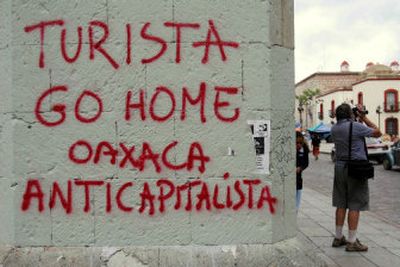Political unrest in Oaxaca paralyzes tourist city

OAXACA, Mexico – Protesters have taken over the center of folkloric Oaxaca, making tourists show identification at makeshift checkpoints, smashing the windows of quaint hotels and spray-painting revolutionary slogans. Police are nowhere in sight.
It’s not the tranquil cultural gem beloved by tourists from the United States and Europe. A month of protests to try to oust the governor have forced authorities to cancel many events, including the Guelaguetza dance festival.
Most tourists are staying away, costing the city millions of dollars.
The protests follow other eruptions of civil unrest and class conflict that have plagued President Vicente Fox as his term comes to a close.
Supporters of leftist presidential candidate Andres Manuel Lopez Obrador are holding nationwide demonstrations to demand a ballot-by-ballot recount in the disputed July 2 presidential election. Federal and state police clashed with striking miners in April and farm protesters in May, leaving four people dead.
But the clashes in Oaxaca have paralyzed one of Mexico’s top cultural tourist attractions, where visitors normally browse traditional markets for Indian handicrafts, hike ancient pyramids and stroll along cobblestone streets to sample mole dishes.
The protests have reduced tourism by 75 percent, costing the city more than $45 million, according to the Mexican Employers Federation, a business lobby.
“Most of the tourists have been scared off. It doesn’t look safe when you have to go through a barricade and everybody is standing there with sticks and stones,” said Chris Schroers, a German who manages a restaurant in the central plaza. “The police are not here. They don’t dare to come into town.”
The protest leaders, a mix of trade unionists and leftists, say their fight is not with the tourists but with Gov. Ulises Ruiz, whom they accuse of rigging the state election in 2004 and using force to repress dissent. Ruiz belongs to the Institutional Revolutionary Party, which has governed the state since 1929.
The movement exploded in late June when police fired tear gas and attacked a demonstration of striking teachers demanding wage increases of about 20 percent.
“We respect and welcome tourists, but it is important they understand that there is a climate of instability and the government is not meeting the demands of the people,” said union leader Enrique Rueda.
However, posters around the city declare the movement is also against the Guelaguetza dance festival because “only the rich and foreigners” can afford the $42 entrance fee.
“We have seen the festival of our people become a circus that is just for whites and gringos and Europeans,” said Rosendo Ramirez, 51, a spokesman for the Oaxaca People’s Assembly, formed to coordinate the protests.
Ramirez says the checkpoints were set up to weed out agitators. But he concedes the group has no control over many protesters, including some anarchists and communists who have joined the movement.
Hotel and restaurant owners are lobbying the Fox administration to help resolve the crisis. They also want the government to declare Oaxaca a disaster area and release federal funds normally reserved for areas hit by earthquakes and hurricanes.
Some fear the tensions might explode if federal troops are sent in.
“There is rising social conflict in Mexico and the government appears impotent and unable to confront it,” historian Lorenzo Meyer said. “If the government doesn’t learn how to control these conflicts, they will only get worse as time goes on.”